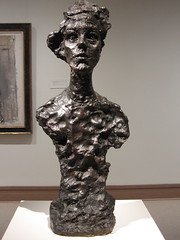
Alberto Giacometti
Photo by Jenny Jackson.
Post by Jenny in New York
Last Sunday afternoon, my day off from Love Brigade, I felt the desire to treat myself to the wonders of the Metropolitan Museum of Art. I entered with an open mind, hoping to find my artistic fulfillment for the day from works by artistic masters. I had no intention of viewing a single exhibition, I merely wanted the works to find me, and they did…
I find it no mistake that I was able to view the Indonesian Textile exhibit on the last day that it was up. Amidst the Arts of Africa, Oceania, and the Americas division on the first floor was a magnificent display of mostly 19th century Ikat textiles. Ikat is an intricate form of textile dying and weaving, native to the Indonesian region, but adopted by other cultures. Ikat textiles are most notably tied to spiritual and ritual ceremonial use. With this method of textile design, each thread is tied onto a loom before woven and made into a design. After delegating the design, the weaver then hand dies each thread individually before weaving the threads on a loom. It is difficult to explain the warp and weft differentiation to those of you who are not textile fanatics, but basically the design is created in one direction before woven with threads of a typically solid color die that are woven in the perpendicular direction, but there can be a combination of designs in both directions. The individual thread dying method creates the characteristically blurry appearance of the patterns on the finished textile. With my camera I took several pictures of my favorite pieces from the Met display: (excuse the poor photography, just snap shots w/ no flash for respect to the fabric) and click here or click the picture on this blog to view the rest of the photos for this post.
Some uses of the Ikat ceremonial textiles are for conceiving the newly born and, conversely, for burying the dead. Sectional pieces of the textile may suggest different meanings. As with the receiving blankets, the textile designs may suggest one’s destiny in life and in the after life according to the placement of threads, colors and designs on the blanket. With burial cloths, Ikat textiles are created to prepare the body for joining the dead ancestors in the after life. The ancestors are represented by a stylized shape, as seen on one textile from the exhibition.
The intricate designs in these delicate textiles have individual purposes which often tell a metaphysical story, in this way I found the Ikats to be relics from the past and now modern treasures.
After much delight from my “Trip up” on the Ikats, I decided that there might be something more for me in that massive museum. Frankly, I wasn’t sure that I had fully received my $5.00 donation’s worth yet. So I walked on…into the modern art gallery, I walked and gazed, recognized, and reflected, then (gasp!) are those Giacometti’s? I thought, nearly out loud. It has been about two years since I was introduced to this artist, first through a drawing of one of his sculptures, but it was his sculptures on display in Paris’ Pompidou Centre that really moved me to a love affair with this artist (perhaps inspired by my own?)
What I love most about Albertto Giacometti’s sculptures is the way in which he conducts an extreme search for the individual(s) whom he is molding. On display at the met there were four separate sculptural works and one painting all of which struck me in a unique way, and yet the same themes throughout his work tend to resurface in my mind.
1: Giacometti nearly destructs the figure by pressing and prodding at the sculptural physique as he explores the human surface in search for the soul.
2: Many figures are lovingly elongated in a seemingly relentless manner.
3: Accentuations on the body figure, unique to each work as to all life objects, move his works into a subjective light. While at a mere glance one may think all Giocomettis appear similar, I find the specific accents the aspect which sets each figure apart.
4: The intentional raw display: an expressionistic portrayal of the body, caused by the pressure from his fingering technique that reveals not necessarily the actual movement of the figure, but more the artist’s own individuality; this regarding his personal movement, his sensual search in relation to the one whom he is recreating sculpturally.
When I look at these works, I feel like I know the artist, as if I am feeling his perception of the individuals or other figures. That I closer see a soul that has perhaps touched him in a certain way, helping me to more profoundly understand humanity in general. It is the depth of Giacometti’s exploration that allows me to reach a more heightened regard for the expressions of love, suffering, sexuality, fear, and adoration. I encourage those of you out there reading this to search for yourself and make your own conclusions from the masterworks of Alberto Giacometti.
Enough for now. More later.
Jenny

Comments